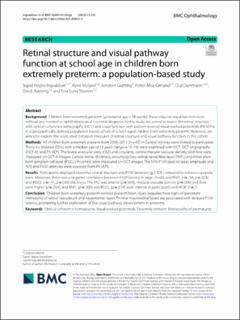| dc.description.abstract | Background
Children born extremely preterm (gestational age < 28 weeks) show reduced visual function even without any cerebral or ophthalmological neonatal diagnosis. In this study, we aimed to assess the retinal structure with optical coherence tomography (OCT) and visual function with pattern-reversal visual evoked potentials (PR-VEPs) in a geographically defined population-based cohort of school-aged children born extremely preterm. Moreover, we aimed to explore the association between measures of retinal structure and visual pathway function in this cohort.
Methods
All children born extremely preterm from 2006–2011 (n = 65) in Central Norway were invited to participate. Thirty-six children (55%) with a median age of 13 years (range = 10–16) were examined with OCT, OCT-angiography (OCT-A), and PR-VEPs. The foveal avascular zone (FAZ) and circularity, central macular vascular density, and flow were measured on OCT-A images. Central retinal thickness, circumpapillary retinal nerve fibre layer (RNFL) and inner plexiform ganglion cell layer (IPGCL) thickness were measured on OCT images. The N70-P100 peak-to-peak amplitude and N70 and P100 latencies were assessed from PR-VEPs.
Results
Participants displayed abnormal retinal structure and P100 latencies (≥ 2 SD) compared to reference populations. Moreover, there was a negative correlation between P100 latency in large checks and RNFL (r = -.54, p = .003) and IPGCL (r = -.41, p = .003) thickness. The FAZ was smaller (p = .003), macular vascular density (p = .006) and flow were higher (p = .004), and RNFL (p = .006) and IPGCL (p = .014) were thinner in participants with ROP (n = 7).
Conclusion
Children born extremely preterm without preterm brain injury sequelae have signs of persistent immaturity of retinal vasculature and neuroretinal layers. Thinner neuroretinal layers are associated with delayed P100 latency, prompting further exploration of the visual pathway development in preterms. | en_US |

